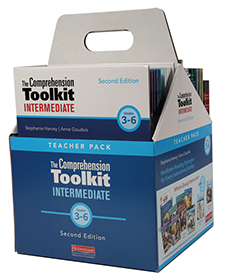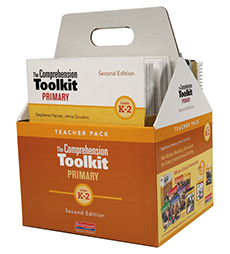Teach Comprehension Across the Curriculum
Put students on the path of lifelong learning by boosting their literacy skills with classroom-ready lessons from The Comprehension Toolkit, designed for grades K–6. Experience a comprehensive approach to teaching comprehension across the content areas using engaging nonfiction texts.
Strategies for Deep Understanding
Dive into a world where inspiring informational texts become gateways to knowledge. The proven strategies of The Comprehension Toolkit ignite curiosity and build comprehension skills essential for academic success across subjects.

Best Practices for Strong Comprehension
Focusing on six research-based comprehension strategies, The Comprehension Toolkit sharpens students’ ability to monitor comprehension, activate background knowledge, ask insightful questions, make inferences, determine importance, and synthesize information—all paving the way for a deeper understanding in the content areas.
Empowering Educator Insights
Supporting growth for both students and educators, The Comprehension Toolkit highlights observable strategies, helping teachers understand students’ thinking, assess their comprehension skills, and tailor instruction to meet diverse learning needs.


High-Interest Nonfiction Texts
Discover a rich collection of high-quality, high-interest nonfiction texts with The Comprehension Toolkit. Engage students, broaden their knowledge base, and develop essential comprehension skills through resources available in print and digital formats, in both English and Spanish, supporting learning in any classroom setting.
Designed for Teaching Success
The Comprehension Toolkit offers guidance on integrating comprehension strategies throughout the curriculum, helping teachers create impactful literacy learning experiences in any content area.

Carefully Structured Instruction
Comprehension skills are explicitly taught, modeled, and practiced through thoughtfully sequenced lessons, encouraging students to think critically about texts across subjects. A gradual release of responsibility model is used to help move students from guided to independent practice.
Fostering Discussion and Collaboration
The Comprehension Toolkit emphasizes rich talk and student collaboration as central to strong comprehension. Teachers learn to incorporate these practices to address diverse learning needs and cultivate a classroom where students become independent, confident readers.


Embedded Coaching and Professional Learning
Expert guidance is embedded within each lesson plan. Additional resources included with The Comprehension Toolkit Teacher Packs provide support in areas such as inquiry-based instruction, small group intervention, and supporting English Language Learners.
Short Nonfiction for American History

The Short Nonfiction for American History series merges purposeful literacy instruction with rich U.S. history content in an all-in-one, ready-to-teach package. Across five era-focused books—Colonial Times, The American Revolution and Constitution, Westward Expansion, The Civil War and Reconstruction, and Industrial Age and Immigration—students read short, high-interest articles alongside primary sources and visuals. They then use clear strategies to annotate, question, summarize, and synthesize ideas. The result is historical literacy in action: students read critically, compare perspectives, evaluate claims and evidence, and build lasting background knowledge. The best part? These resources can be used in ELA classes, social studies, or both.
Get Started: Shop The Comprehension Toolkit
Available in Primary (K–2) and Intermediate (3–6) sets, The Comprehension Toolkit provides strategies that help students understand, respond to, and learn from nonfiction text—building background knowledge across the curriculum and throughout the year.
Go Deeper: Explore The Comprehension Toolkit
Watch this in-depth walkthrough of The Intermediate Comprehension Toolkit.
Navigation Guides
The following Navigation Guides highlight the lesson goals and teaching language across all components of The Comprehension Toolkit. Click below to explore each component and see how they help differentiate instruction to meet the learning needs and interests of your students.
The Primary Comprehension Toolkit Navigation Guide
The Intermediate Comprehension Toolkit Navigation Guide
Learn More About The Comprehension Toolkit
Related Resources
Stay Updated: Related Blog Posts

Comprehension at the Core: Teaching for Engagement, Understanding, and Building Knowledge
Comprehension instruction centers on the kinds of thinking proficient readers use to understand what they read. Kids need a repertoire of strategies that allows them to read a text and work out their thinking to construct meaning.

Prepare Kids for Test Taking with Comprehension Strategies that Build Strong Readers
Kids need to become powerful, effective readers who tackle complex texts with confidence. Teaching comprehension strategies creates skilled, thoughtful readers who build knowledge and understanding through real world reading.

How to Integrate Comprehension Strategies into Content Area Learning
When we talk about teaching, it's not just about the content we deliver; it's about how we help students engage with and understand that content. Learn about the power of teaching comprehension strategies within the content areas.









